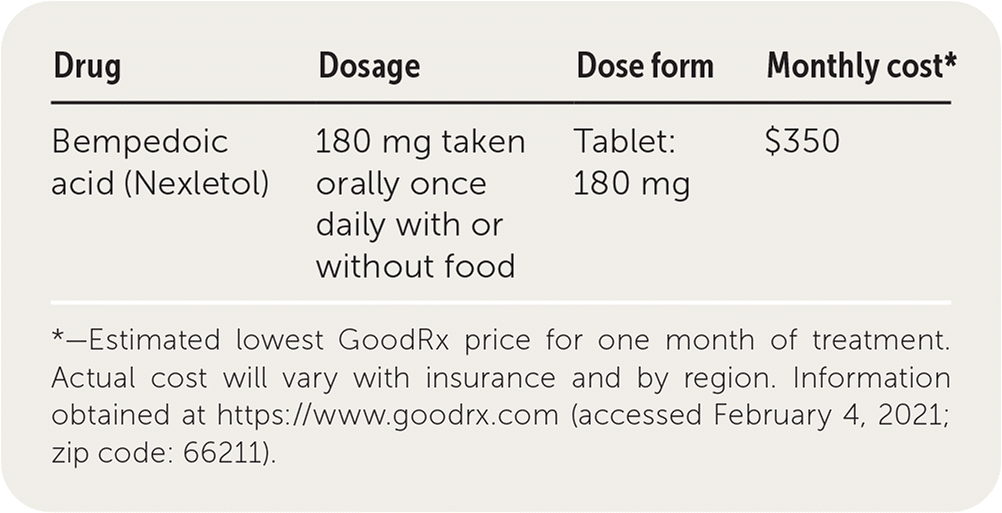
Am Fam Physician. 2021;103(6):377-378
Author disclosure: No relevant financial affiliations.
Bempedoic acid (Nexletol) is labeled as an adjunct to diet plus a maximally tolerated dosage of statin for the treatment of familial hypercholesterolemia or atherosclerotic cardiovascular disease (ASCVD)in patients requiring additional reduction of low-density lipoprotein (LDL) cholesterol.1 Bempedoic acid lowers LDL cholesterol by inhibiting ATP citrate lyase. This mechanism differs from statins, which inhibit the HMG-CoA reductase enzyme.

| Drug | Dosage | Dose form | Monthly cost* |
|---|---|---|---|
| Bempedoic acid (Nexletol) | 180 mg taken orally once daily with or without food | Tablet: 180 mg | $350 |
Safety
Patients taking bempedoic acid are at risk of increased serum uric acid levels and tendon rupture. Serum uric acid may increase by 0.6 mg per dL (0.04 mmol per L) to 0.9 mg per dL (0.05 mmol per L) from baseline, usually in the first four weeks of treatment. Clinically significant hyperuricemia will develop in 3.5% of patients.2–5 Gout has been shown to occur in 1.5% of patients on bempedoic acid therapy, and about 10% of patients with a history of gout will experience a gout attack. Patients taking bempedoic acid should be monitored for signs and symptoms of hyperuricemia, and serum uric acid should be assessed as indicated. Tendon rupture has been reported in 0.5% of patients, usually within weeks to months of starting treatment with bempedoic acid.1 Patients at higher risk of tendon rupture include those older than 60 years, patients taking corticosteroids or fluoroquinolones, patients with kidney failure, and those with previous tendon disorders. Patients should discontinue use of bempedoic acid if tendon rupture occurs. In clinical trials, benign prostatic hyper-trophy and atrial fibrillation occurred at a higher rate than with placebo. Kidney, liver, and blood indices can be mildly affected by treatment, but typically these changes are not clinically important. Rates of myalgia in patients taking bempedoic acid are similar to those seen with placebo and occur in about 3% to 6% of patients.2–5 Although there are no human data on use of bempedoic acid during pregnancy, animal studies suggest skeletal variations, decreased fetal weight, and fetal loss. Bempedoic acid should not be used in patients who are pregnant or breastfeeding.1 Bempedoic acid has not been studied in children.1
Tolerability
Bempedoic acid is well tolerated by most patients. The most common adverse effects leading to discontinuation include muscle spasms, extremity pain, arthralgia, and diarrhea.3,5 About 11% of patients will discontinue use of bempedoic acid because of adverse effects. Discontinuation rates were similar to those of ezetimibe (Zetia) in one comparison trial.2 In patients taking simvastatin (Zocor) and pravastatin (Pravachol) in addition to bempedoic acid, the daily dosage of simvastatin and pravastatin should be limited to 20 mg and 40 mg, respectively, to minimize the risk of myopathy.1
Effectiveness
In a trial of 345 patients with a history of statin intolerance, LDL cholesterol decreased by 21%, from an average of 159 mg per dL (4.09 mmol per L) to 119 mg per dL (3.06 mmol per L), with the addition of bempedoic acid vs. placebo. The majority of these patients were not on background lipid-lowering therapy.4 However, bempedoic acid is not currently labeled for monotherapy.
Investigators evaluated two studies that included a total of 3,009 patients with ASCVD (95% of patients) and/or heterozygous familial hypercholesterolemia (5% of patients). Patients with LDL cholesterol of 70 mg per dL (1.81 mmol per L) or more despite maximally tolerated statin therapy with or without other lipid-lowering drugs were randomized to treatment with bempedoic acid or placebo for 52 weeks. The primary effectiveness outcome was the percentage change in LDL cholesterol at 12 weeks. The addition of bempedoic acid lowered LDL cholesterol 17% more than placebo in one of the studies, from a mean baseline of 119 mg per dL to 98 mg per dL (2.54 mmol per L). In the other study, LDL cholesterol decreased 18% more with bempedoic acid than in patients treated with placebo, from a mean baseline of 104 mg per dL (2.69 mmol per L) to 84 mg per dL (2.18 mmol per L). More patients treated with bempedoic acid achieved LDL cholesterol levels less than 70 mg per dL compared with placebo (32% vs. 9%, respectively). Improvements in LDL cholesterol were maintained at 52 weeks and were present regardless of initial statin intensity. Secondary measures of other atherogenic lipoproteins and inflammatory biomarkers were also significantly improved.3,5
Two smaller studies investigated the effectiveness of bempedoic acid plus ezetimibe. Bempedoic acid and ezetimibe in a fixed-dose combination (Nexlizet) taken with maximally tolerated statin therapy lowered LDL cholesterol by 38% compared with placebo and by 13% compared with ezetimibe monotherapy. When bempedoic acid was added to ezetimibe in patients with statin intolerance, LDL cholesterol was lowered by 29% more than in those taking placebo.2,6
Bempedoic acid has not been adequately studied in combination with or compared with proprotein convertase subtilisin/kexin type 9 (PCSK9) inhibitors. No data are currently available on the long-term incidence of major cardiovascular morbidity and mortality in patients taking bempedoic acid. It has not been fully evaluated for primary prevention.
Price
A one-month supply of bempedoic acid costs about $350, in addition to existing treatment. This is significantly more expensive than ezetimibe, which costs about $20 for a 30-day supply. However, bempedoic acid costs much less than a PCSK9 inhibitor.
Simplicity
The recommended dosage of bempedoic acid is 180 mg taken orally once daily with or without food. There are no contraindications in the current prescribing information. Lipid levels should be analyzed eight to 12 weeks after initiating bempedoic acid therapy.1
Bottom Line
Bempedoic acid may serve as an alternative to ezetimibe or be used in combination with it to achieve additional LDL cholesterol lowering beyond maximally tolerated statin therapy in patients with established ASCVD or familial hypercholesterolemia. More studies are needed to establish the role of bempedoic acid in primary prevention. It is not known whether bempedoic acid improves cardiovascular outcomes.
